 USN (1923-26)- USS Barracuda, Bass, Bonita (V-1, 2, 3, later SS-163-164-165)
USN (1923-26)- USS Barracuda, Bass, Bonita (V-1, 2, 3, later SS-163-164-165)WW2 US submarines:
O class | R class | S class | T class | Barracuda class | USS Argonaut | Narwhal class | USS Dolphin | Cachalot class | Porpoise class | Salmon class | Sargo class | Tambor class | Mackerel class | Gato class | Balao class | Tench classTo start a new deep dive into US Navy interwar and WW2 submarines, we need to go back to 1911 and some already asking questions about the capabilities of submarines to take part in fleet operations, with battleships, instead of remaining coastal defence assets. Electric Boat (John Holland’s company) proposed such a design as early as 1913. Proposals were made of large, powerful fleet submersibles capable of 21 knots, but the road was long and harduous. The three 1916 AA-1 class fleet subs proved quite disappointing mostly due to excessive vibrations with their five diesel arrangement, and yet in 1921 under the new “V programm” a new generation was started, voted in 1916, but built postwar. All seven of these “V boats” were experimental and groundbreaking. The first three were large fleet (oceanic) boats, and the last three cruiser submersibles, the only USN attempt. The first V1, 2 and 3 were later renamed Barracuda, Bass and Bonita, and they inaugurated a brand new diesel-electric arrangement. There again however they proved unreliable and were decommissioned after ten years service, reactivated in WW2 to defend the Panama Canal, for experiments and training. #ww2 #usn #Unitesstatesnavy #submersible #barracudaclass #vclasssubmarines
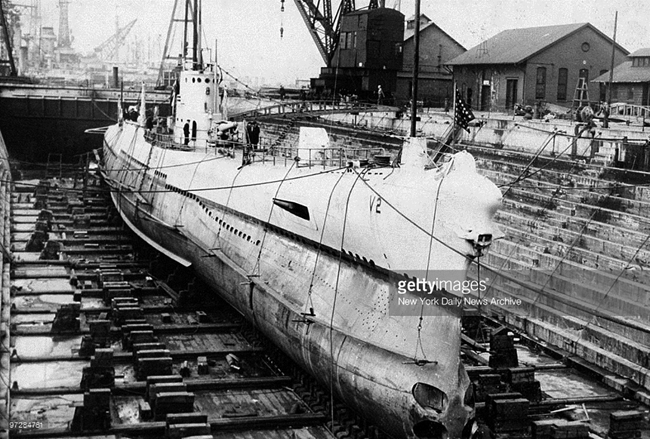
USS Bass in drydock
Development
Only 12 years after John Holland pioneer the USN underwater force, naval strategists started to think on how submarines could operate in closer collaboration with surface units instead of sticking to coastal defense as torpedo boats. This capacity to screen the fleet in a discreet way however had a catch, which was to rething their design as to be larger and better armed, and crucially as furface speed compatible with the fleet of 21 knots (24 mph; 39 km/h) just to keep pace with battleships, notably those of the “standard-type”.
The summer of 1913, Electric Boat’s architect and chief designer Lawrence Y. Spear, proposed two fleet-boat designs for the USN 1914 program, without any formal request. This was accepted and later voted for eight by Congress which added that these would “be of a seagoing type, to have a surface speed of not less than twenty knots”.
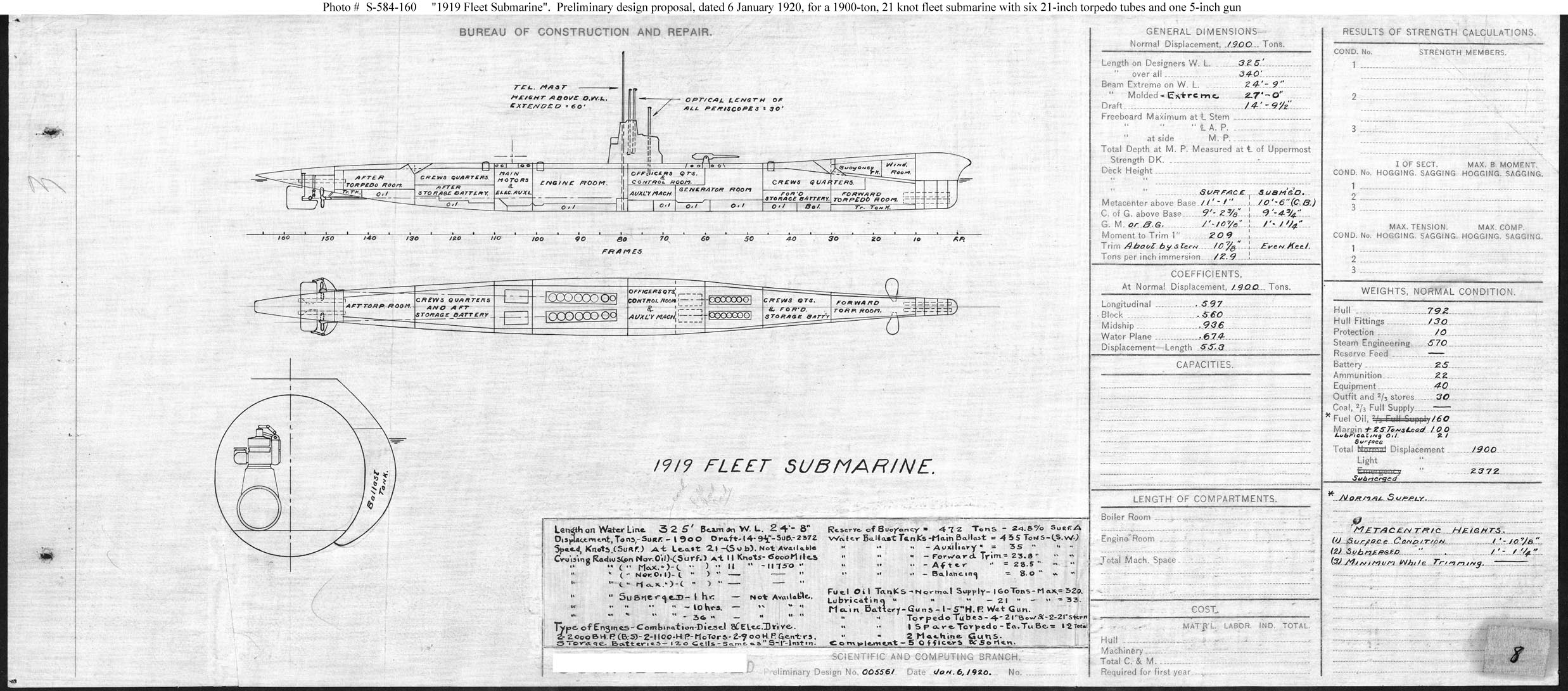
Fleet submarine, 1919 study, the main preliminary design proposal dated 6 January 1920 which led to the 1900 tonnes V1 class, prepared by BuC&R.
The first fleet subs, ill-fated AA-1 class
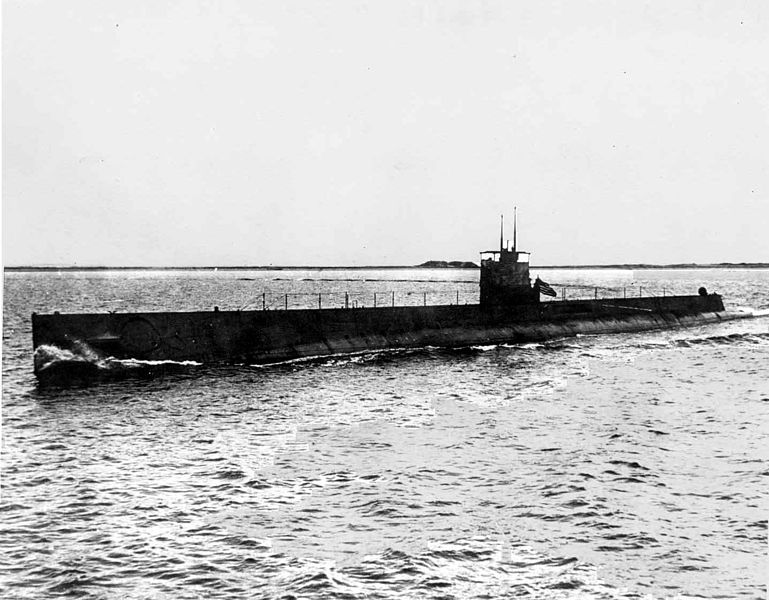
The first of these new fleet boats was laid down in June 1916 and named USS Schley, honoring 1898 war hero Winfield Scott Schley.
Displacing 1,106 long tons (1,124 t) surfaced, 1,487 long tons (1,511 t) submerged she was as large as a destroyer, for 270 ft (82 m) long. When commissioned on 30 January 1920 she became later the lead boat of the AA-1, later T-1 class.
The most daunting task, to achieve the set speed, required to install two tandem 1,000 hp (750 kW) diesel engines on each shaft, twin prop screws, plus a separate diesel generator just to charge batteries. That way all available power would be concentrating without loss or second task on the shaft. Schley and two sisters as part of the 1915 program had a design speed of 20 knots (23 mph; 37 km/h) but such untetested speed came with a hitch: Massive torsional vibration issues caused by the coupling of the engines in tandem mountings. The main issue was that these engines were clutched together. Not only they failed to achieve their design speed but proved vey troublesome to the point the class was cancelled and they were decommissioned in 1922-1923, seeing very little service.
And yet, in 1916, so well before these boats were tested, the Congress enthusiastically approved nine additional “fleet” boats (plus 58 coastal submarines). The latter were to be of a larger 800 long tons (813 t) coastal boat type. This became the successful S class, used in WW2 as well. The nine “fleet boats” however were suspended, and eventually they later became the “V-boats”, built postwar, between 1921 and 1934, as the so-called “V” class. In reality they all diverged and tested various concepts, three of them being impressive sub cruisers with more outstanding projects with cruisers or even battleships guns proposed by BuShips in this decade. V-1 to V-3 (The Barracuda) were direct successors of the AA-1 class, were designed to reach a speed of 21 knots but with a solid review of their powerplant to avoid the pitfall of the previous design.
The postwar V class, infused with German tech
The first three V-boats were funded in fiscal year 1919. Later to be known as the “Barracuda class”, they were laid down at Portsmouth Navy Yard by October and November 1921, and commissioned roughly a year apart in 1924-1926. They had been infused with what could be learned from German war prizes U-Boats, notably their powerful diesel engines, to be able to perform as “fleet boat” with a high surface speed, and were indeed even larger than the AA-T1 class at 2,119 long tons (2,153 t) surfaced, 2,506 long tons (2,546 t) submerged for 342 ft (104 m). True giants of the day and yet powered in a safer way by studying German diesels.
The following V-4, 5 and 6, later renamed USS Argonaut (largest US Submarine before USS nautilus in 1954), USS Narwhal and Nautilus of the same class, tested the concept of sub cruisers, twice as large as fleet subs, but they proved disappointing. They were used in completely diffent roles in WW2, inaugurating the use of submarine for special operations. The V1 or Barracuda class are the first of three posts devoted on the birth of interwar submarines, up to the famous wartime Gato, Tench and Balao classes.
Design of the class

V-2 (SS-164) overhauled, drydock, Brooklyn Navy Yard, showing her peculiar bow. Photo by Harry Warnecke for NY Daily News (Getty Images).
The first post-WWI submarines, these fast fleet boats were the first of nine (V1-V9) authorised as part of the big 1916 programme. They were about twice the size of the surviving ‘S’ class boats, and were even larger than the three wartime ‘T’ class boats broken up under the London Treaty of 1930. However, as thev were being designed, interest within the Navy shifted towards very long-range cruiser submarines of relatively modest speed, modelled (in theory) on the German cruisers of World War I.
This led to the design of the much larger minelayer Argonaut (V4) and of the two heavy-gun cruisers Narwhal and Nautilus, VS and V6. Nomenclature demands some explanation: when all US submarines were distinguished only by a letter and a number, these were “V-boats’. In 1931 the submarines were named and at the same time were given new letter-number combinations based on their names, in this case B1 to B3. However, these three submarines were also at one time designated SF (fleet submarines) 4 to 6; Argonaut was SF7, and the two Narwhals SF8 and 9. The large, relatively unsuccessful “T’ class was numbered SF 1-3 under this system.
Propulsion was by two direct-drive diesels plus two others driving through motor-generators (‘composite system’) and much of the increase in size compared to the earlier ‘S’ class can be traced to the requirement for high speed to keep up with the battle fleet; range was 6000nm at 1 1kts (surfaced). They were designed to dive to 200ft (pressure hull axis). The 5in gun was replaced by a 3in weapon in 1928. The three ‘Bs’ were not particularly successful, and they were laid up for some time prior to the outbreak of war. They were partly re-engined prewar, the original Sulzer generating diesels being replaced by MAN units of higher power. War service was limited to training, and plans to convert them to transport submarines (APS2-4) were abandoned; all were stricken 10 March 1945.
USS Barracuda’s keel was laid down at Portsmouth Navy Yard, she was launched as V-1 (SF-4) on 17 July 1924, commissioned on 1 October 1924. Hr sisters V-2 (Bass) and V-3 (Bonita) were designed at the core to reach and if possible, beat the requirement of a surface speed of 21 knots (39 km/h) to work with battleships.
Hull and general design
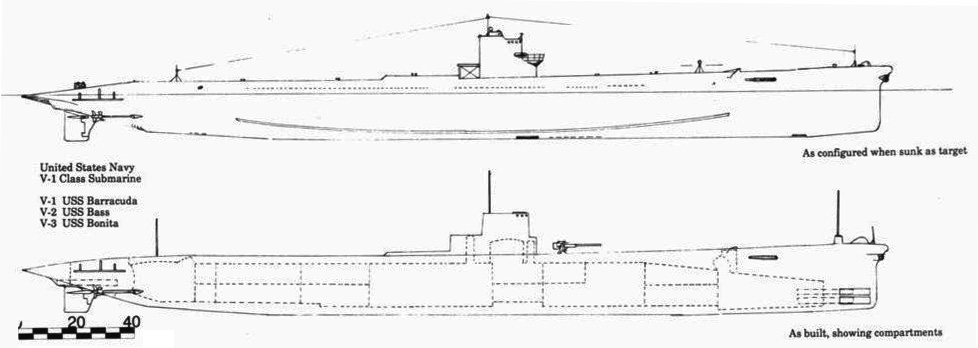
USS Bass (SS-164) as built and stripped as target. Cutaway with compartments, engine and control room, battery-charging engine, maneuvering room (above the motor room) as well as the crew’s quarters above the aft battery and the crew’s mess as well as the aft torpedo room and steering gear room. There were berthings in the small upper deck compartment, above the forward engine room and there were the officer’s quarters above the forward battery and forward torpedo room. Drawing by Jim Christley “U.S. Submarines Through 1945, Illustrated Design History by Norman Friedman”. src
The V1 class were the largest submersibles ever built for the United States Navy up to that point. The previous solution of pairing smaller diesels proved a disastrous one in retrospect, and as the design proceeded in 1920-21, it was clear that a new type of powerplant was required to provide the right output. The AA-T1 were originally powered by four New London Ship & Engine (NELSECO), each were four cycle six-cylinder diesels rated for 1,000 hp (750 kW) each. They came with two Electro Dynamic main motors rated each at 675 hp (503 kW) in direct drive. There was one spare NELSECO four cycle, but four-cylinder auxiliary diesel just to feed the batteries, two banks of 60 Exide types. The utter mediocre performances led to fit instead two Maschinenfabrik Augsburg Nürnberg AG (MAN) four cycle ten-cylinder diesels rated each for 2,350 hp (1,750 kW). This cured the vibration problems and provided a technical roadmap for future submersible diesels.
The V-Boats were partially double-hulled. They had forward buoyancy tanks inside a bulbous bow in order to stabilize them while surface running, improving sea-keeping. The hull was somewhat refined compared to the previous fleet boats, taking in account some hydrodynamic features of the war prize subs. The design of the bow was very peculiar, raised for extra seakeeping. In fact they had two bulges, top and bottom. The conning tower was more developed than previous WW1 designs, with an enclosed bridge with portholes, relatively large, with a step, and aft platform. Both guns had a semi-sponsoned platform sfore and aft as originaly they were to have two main 5-in guns/51 caliber, but just one was kept, later replaced (see below). There was also an aft raised exhaust section behind the conning tower, located roughly amidships. As usual there was a wireless telegraphy cable suspended fore and aft between poles and the CT mainmast. The hull had a single under belly jettisonable ballast keel, two counterkeels, and the tail’s propeller span was protected above by two side “bumpers”.
Powerplant
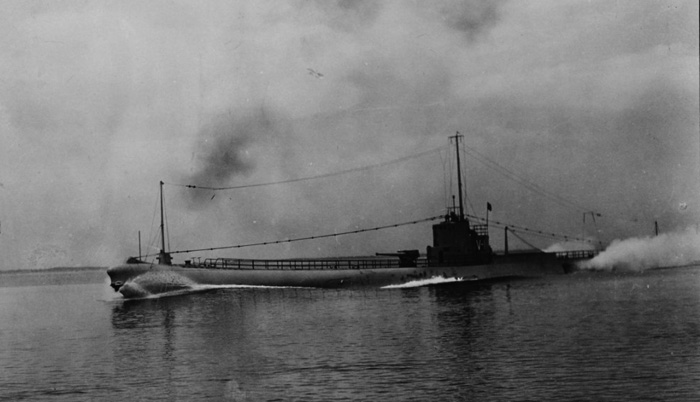
USS BARRACUDA (SS-163) running trials at full speed, off Portsmouth, New Hampshire, 5 June 1926. src: Naval History and Heritage Command
The V1 propulsion plant was based on a large hull for redundancy, in order to be divided between two separate engine rooms both forward and aft of the control room. The forward pair were independent 1,000 hp (750 kW) diesel Busch-Sulzer auxiliary diesel engines used as generators to charge the battery and provide an extra boost in surface. In the aft compartment were located two 2,250 hp (1,680 kW) main-propulsion direct-drive diesels. These were Busch-Sulzer types also. They forward pair added their output to the mechanically coupled main-propulsion engines by driving 1,200 hp (890 kW) Elliott electric motors, fed by two 60-cell Exide batteries units, which was a partial or “hybrid” diesel-electric propulsion system.
This pioneered future standards for diesel-electric submarines, but reliability required a full decade to mature. That’s why early submersibles series were limited to just one or two boats until the 1936 Perch class.
In the end when trialled all three “V-boats” were equally a disappointment as their forebears performance-wise. They onl could reach 18.7 kn (21.5 mph), so failing to reach their contracted surface speed of 21 knots and also failing to mee their underwater speed of 9 knots (10 mph; 17 km/h). They were not plagues by vribrations but proved too heavy forward, thus their surface seakeeping was abysmal. The need to lighten them up led later to sacrificve the two heavy deck guns originally planned for a single 3-inch (76 mm)/50 gun in 1928. Yet still, both the main Busch-Sulzer diesels and Elliott electric motors were found unreliable. The boats practically never reach full-power.
Armament
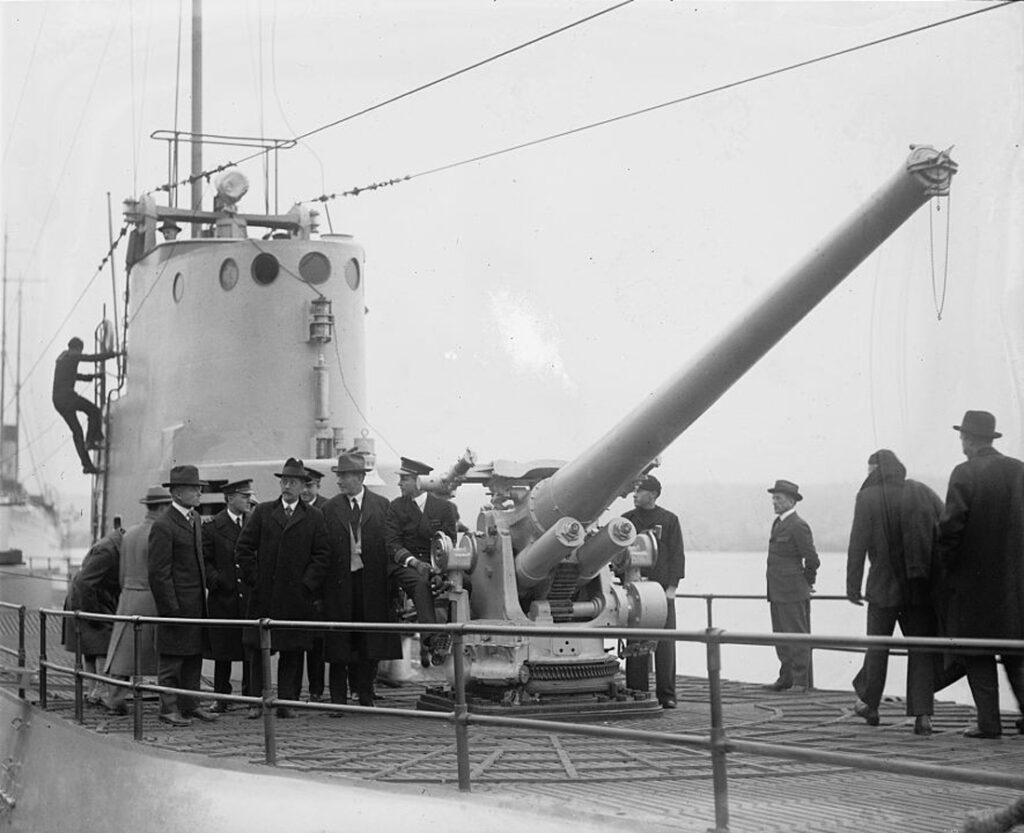
Secretary of the Navy Curtis Dwight Wilbur inspecting V-1 (SS-163) at Navy Yard, 12/3/24. Library of Congress Prints and Photographs Division, via Bill Gonyo. Showin the tall conning tower and massive initial 5-in/50 main gun forward.
They were armed with six 21-inch (533 mm) torpedo tubes, four forward in the lower bulge and two aft, with 12 torpedoes, so just a single reload per tube.
Navweaps entry on the 5-in/51
Navweaps entry on the 3-in/50
The initial two guns were later reduced to a single forward main gun, 5-inch (127 mm)/51 caliber deck gun. Due to overweight and stability issues when trialled surfaced, it was deleted in 1928, replaced by a much lighter 3-in/50 standard gun.

Profile associated with the “History of the V-2 (SS-164)” courtesy of Scott Koen & ussnewyork.com.
⚙ specifications V-1 (Barracuda)-class |
|
| Displacement | 2,119 tons (2,153 t) surfaced, 2,506 tons (2,546 t) submerged |
| Dimensions | 341 ft 6 in x 27 feet 6 in x 15 ft 2 in (104.09 x 8.398 x 4.62 m) |
| Propulsion | 2× shafts Busch-Sulzer diesels 2,250 hp (1,680 kW), ADE 1,000 hp DED see notes |
| Speed | 21 knots (39 km/h) surfaced, 9 knots (17 km/h) submerged |
| Range | 6,000 nm (11,000 km) at 11 knots, 10 hours at 5 knots |
| Armament | 6× 21-in (530 mm) TTs, 1× 5 inch/51 cal. deck gun |
| Test depth | 200 ft (60 m) |
| Crew | 7 officers, 11 petty officers, 69 enlisted |
Modernization
Renamed Barracuda, Bass, and Bonita in 1931, they were decommissioned in 1937, and only the imminence of World War II provided a reprieve, in preparation for which they were recommissioned in September 1940. Just before Pearl Harbor, the three boats were transferred to Coco Solo, Panama Canal Zone, and each made a number of defensive war patrols (without seeing any action) off the approaches to the Panama Canal.
All three boats were overhauled in Philadelphia, Pennsylvania, in late 1942 and early 1943, and converted to cargo submarines by removing both torpedo tubes and main engines, thereby leaving them solely dependent on their diesel generators for propulsion. Because this rendered the boats severely underpowered, they apparently never served operationally in their cargo-carrying role, but instead were relegated to training duties at New London until just before the end of the war in 1945. After decommissioning, Barracuda and Bonita were scrapped, and Bass was scuttled as a sonar target near Block Island, Rhode Island.
 USS Barracuda
USS Barracuda
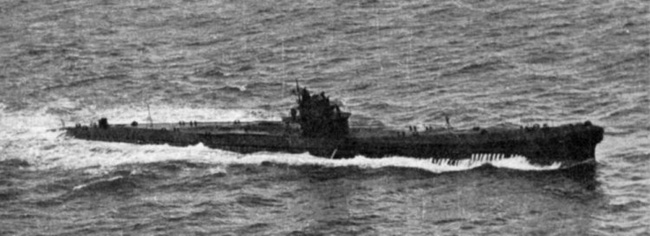
uss V-1 was commissioned in 1924 and started trials surfaced only, assigned to Submarine Division 20. After further trials she was sent to the New England coast from 14 January 1925, surfaced all the way to the Caribbean Sea and back by May 1925 for official completion. She passeed all her trials, dive and weapons qualifications while cruising along the Atlantic coast and Caribbean up to November 1927.
On 8 November her Squadron left Portsmouth for San Diego, via Panama, arriving on 3 December. Until May 1932 USS V-1 stayed with the Pacific SubDiv20 with local training in Hawaii and back hops to the Caribbean. In 1928 her 5 inch/51 gun was replaced by a 3 in/50 and she was renamed USS Barracuda on 9 March 1931, hull SS-163 from 1st July 1931. In May 1932 she was placed in the Rotating Reserve with SubDiv15 at Mare Island and by January 1933 she was reassigned to SubDiv12, west coast, Pearl Harbor, Panama Canal Zone. On 28 October 1936 she crossed Panama for a Gravimetric Survey Expedition in the Caribbean. On 8 January 1937 Barracuda sailed from the Virgin Islands, and arrived on 14 January at Philadelphia, decommissioned 14 May 1937. In peacetilme she would have been likely sold for scrap.
However as the war broke out she was recommissioned at Portsmouth on 5 September 1940, reassigned to SubDiv9. On 2 March 1941 she patrolled off Bermuda, with SubDiv71. She left New London in Connecticut on 17 November 1941 for the Pacific Fleet and patrolled the Pacific side of the Panama canal until 15 December 1941, back to the the Atlantic Fleet and until 7 September 1942 with SubDiv 31 for six war patrols southwest of Panama.
On 7 Sept. again she was based in Coco Solo, Canal Zone and after a short maintenance was sent to Philadelphia for her main overhaul and modernization. It was decided due to her large size like the other “V” subs, to convert her as cargo submarine. Her aft main engines were removed to accomodate storage, so she was left with her auxiliary engines and so low speed. She awaited orders based in New London until February 1945, being a tender for SubDiv 13 and 31. She was used as ASW target for destroyers and other submarines as well as planes in Block Island Sound. She thebn proceeded to Philadelphia NyD on 16 February 1945, decommissioned 3 March, sold 16 November, BU.
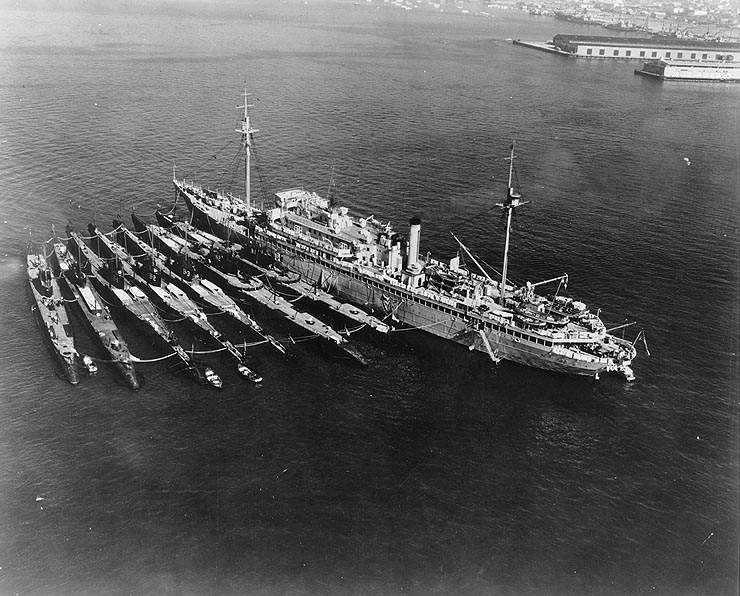
The sub tender USS Holland with all the “V” class together at San Diego, 24 Dec. 1934
 USS Bass (SS-164)
USS Bass (SS-164)
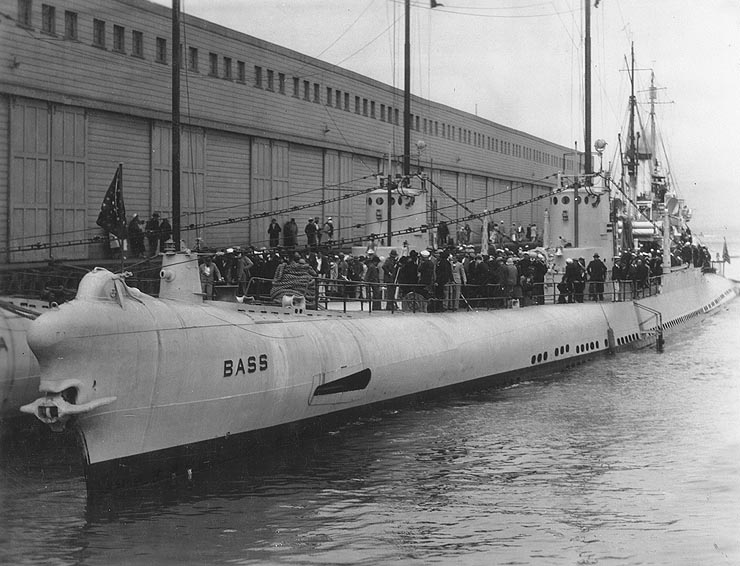
V-2 once commissioned, was assigned to Submarine Division 20 (SubDiv 20) Atlantic coast-Caribbean Sea, until November 1927. Like her sister her division was moved to San Diego in California, based here from 3 December 1927. Her PacFleet routine went on until December 1932. Renamed Bass on 9 March 1931, to SubDiv 12, April 1931. Hull class. to SS-164 (previously SF-5) on 1st July. 2 January 1933, she was reaassigned to Rotating Reserve SubDiv 15 in San Diego. Resumed her routine on West Coast, Canal Zone, Hawaii until January 1937. Reassigned to the West Coast, Philadelphia on 18 February 1937, decommissioned, reserve 9 June.
She was recommissioned at Portsmouth on 5 September 1940, assigned to SubDiv 9 (Atlantic Fleet) and patrolled New England by February–November 1941 with patrol cruises to St. George in Bermuda and permanent base at Coco Solo, Canal Zone from 24 November until Pearl Harbor.
By January 1942 she was reassigned to SubRon 3, SubDiv 31, Atlantic Fleet, still at Coco Solo, with four Pacific war patrols off Balboa. On 17 August 1942 her after battery room was engulfed in flames, reaching the aft torpedo room and starboard main electric motor. It was so quick 26 of her crew perished by asphyxiation. She was assisted, surfaced, the next day by USS Antaeus, escorted her to the Gulf of Dulce in Costa Rica, then Balboa.
She left the Canal Zone on October 1942, moved to Philadelphia on the 19th was overhauled, converted to a cargo submarine abnd like her sister Barracuda, based in New London for secret experiments off Block Island by December 1943. She had another refit at Philadelphia January–March 1944 and until the end of the war was assigned to SubRon 1, Atlantic Fleet, HP New London and cruising between Long Island and Block Island. She was decommissioned at New London sub based on 3 March 1945, sunk as target to test the Mark 24 Fido acoustic homing torpedo on 12 March 1945.
 USS Bonita (SS-165)
USS Bonita (SS-165)
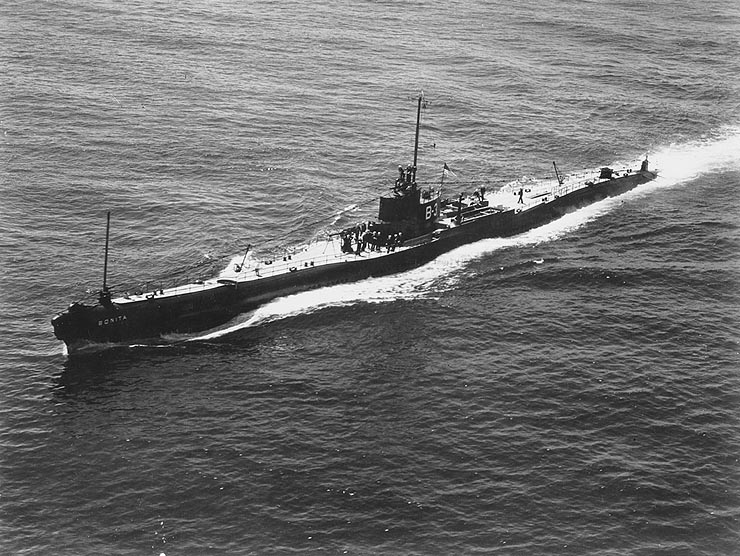
USS Bonita in wartime with her new all black livery.
USS Bonita was assigned after completion of her trials and qualifications to Submarine Division 20 (SubDiv 20) like her two sisters. She operated along the East Coast and Caribbean Sea and from November 1927 left for San Diego, Pacific Fleet, starting service from 17 December 1927. She was also detached to SubDiv 12 and made yearly cruises to Hawaii, until reassigned to SubDiv 15 of the Rotating Reserve, Mare Island Navy Yard from 1 June 1932. Like her two sisters she had the gun swap, was renamed Bonita, SS-165.
She was reassigned to SubDiv 12 in September 1933 sent to the Caribbean Sea and West Coast, Hawaii until 1936 then left San Diego on 20 January 1937 to Philadelphia on 18 February, decommissioned on 4 June 1937.
Recommissioned on 5 September 1940, was assigned to Coco Solo naval base in the Panama Canal Zone, Pacific sector. Next she returned to the east coast, Philadelphia for overhaul on October 1942 converted as cargo submarine and sent to patrol Maine coast until mid-1943. Reassigned to SubRon 1 and SubDiv 13, training, New London until February 1945. Sent for preparations of inactivation at Philadelphia Navy Yard on 17 February, decommissioned 3 March, stricken, sold 28 October 1945 for scrap.
Read More/Src
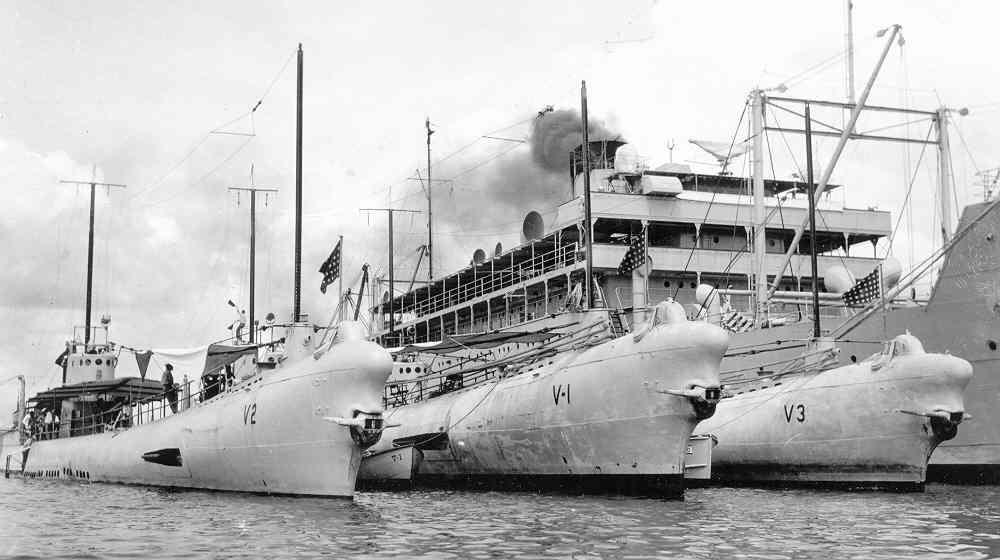
All three V class Barracuda moored at the tender USS Argonne (AS-10), San Diego, circa 1927. src
Books
Lenton, H. T. American Submarines (Navies of the Second World War) (Doubleday, 1973)
Silverstone, Paul H., U.S. Warships of World War II (Ian Allan, 1965)
Campbell, John Naval Weapons of World War Two NIP 1985
Friedman, Norman “US Submarines through 1945: An Illustrated Design History” NIP
Gardiner, Robert and Chesneau, Roger, Conway’s All the World’s Fighting Ships 1922–1946, Conway Maritime Press, 1980
Links
history.navy.mil barracuda-ii.html
pigboats.com V-class
navsource.org/
oneternalpatrol.com uss-bass-
http://www.wreckhunters.net/
en.wikipedia.org USS_Barracuda_(SS-163)
en.wikipedia.org V-boat
shipbucket.com/forums/ appearance of the class

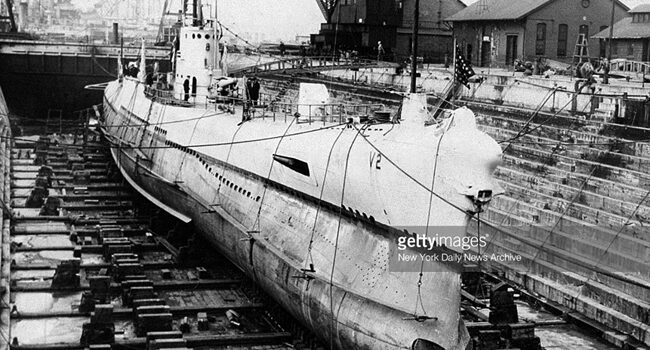
 Latest Facebook Entry -
Latest Facebook Entry -  X(Tweeter) Naval Encyclopedia's deck archive
X(Tweeter) Naval Encyclopedia's deck archive Instagram (@navalencyc)
Instagram (@navalencyc)





 French Navy
French Navy Royal Navy
Royal Navy Russian Navy
Russian Navy Armada Espanola
Armada Espanola Austrian Navy
Austrian Navy K.u.K. Kriegsmarine
K.u.K. Kriegsmarine Dansk Marine
Dansk Marine Nautiko Hellenon
Nautiko Hellenon Koninklije Marine 1870
Koninklije Marine 1870 Marinha do Brasil
Marinha do Brasil Osmanlı Donanması
Osmanlı Donanması Marina Do Peru
Marina Do Peru Marinha do Portugal
Marinha do Portugal Regia Marina 1870
Regia Marina 1870 Nihhon Kaigun 1870
Nihhon Kaigun 1870 Preußische Marine 1870
Preußische Marine 1870 Russkiy Flot 1870
Russkiy Flot 1870 Svenska marinen
Svenska marinen Søværnet
Søværnet Union Navy
Union Navy Confederate Navy
Confederate Navy Armada de Argentina
Armada de Argentina Imperial Chinese Navy
Imperial Chinese Navy Marinha do Portugal
Marinha do Portugal Mexico
Mexico Kaiserliche Marine
Kaiserliche Marine 1898 US Navy
1898 US Navy Sovietskiy Flot
Sovietskiy Flot Royal Canadian Navy
Royal Canadian Navy Royal Australian Navy
Royal Australian Navy RNZN Fleet
RNZN Fleet Chinese Navy 1937
Chinese Navy 1937 Kriegsmarine
Kriegsmarine Chilean Navy
Chilean Navy Danish Navy
Danish Navy Finnish Navy
Finnish Navy Hellenic Navy
Hellenic Navy Polish Navy
Polish Navy Romanian Navy
Romanian Navy Turkish Navy
Turkish Navy Royal Yugoslav Navy
Royal Yugoslav Navy Royal Thai Navy
Royal Thai Navy Minor Navies
Minor Navies Albania
Albania Austria
Austria Belgium
Belgium Columbia
Columbia Costa Rica
Costa Rica Cuba
Cuba Czechoslovakia
Czechoslovakia Dominican Republic
Dominican Republic Haiti
Haiti Hungary
Hungary Honduras
Honduras Estonia
Estonia Iceland
Iceland Eire
Eire Equador
Equador Iran
Iran Iraq
Iraq Latvia
Latvia Liberia
Liberia Lithuania
Lithuania Mandchukuo
Mandchukuo Morocco
Morocco Nicaragua
Nicaragua Persia
Persia San Salvador
San Salvador Sarawak
Sarawak Uruguay
Uruguay Venezuela
Venezuela Zanzibar
Zanzibar Warsaw Pact Navies
Warsaw Pact Navies Bulgaria
Bulgaria Hungary
Hungary

 Bundesmarine
Bundesmarine Dutch Navy
Dutch Navy Hellenic Navy
Hellenic Navy Marina Militare
Marina Militare Yugoslav Navy
Yugoslav Navy Chinese Navy
Chinese Navy Indian Navy
Indian Navy Indonesian Navy
Indonesian Navy JMSDF
JMSDF North Korean Navy
North Korean Navy Pakistani Navy
Pakistani Navy Philippines Navy
Philippines Navy ROKN
ROKN Rep. of Singapore Navy
Rep. of Singapore Navy Taiwanese Navy
Taiwanese Navy IDF Navy
IDF Navy Saudi Navy
Saudi Navy Royal New Zealand Navy
Royal New Zealand Navy Egyptian Navy
Egyptian Navy South African Navy
South African Navy






























 Ukrainian Navy
Ukrainian Navy dbodesign
dbodesign